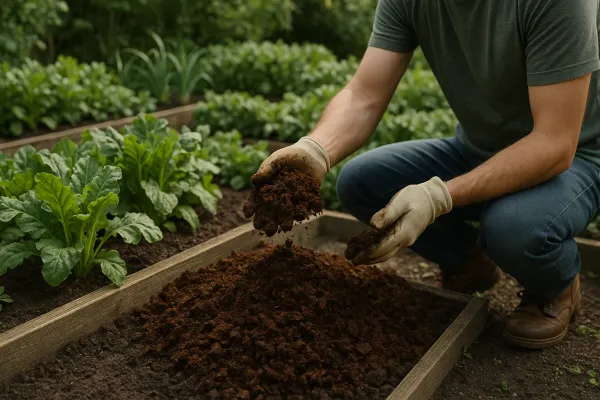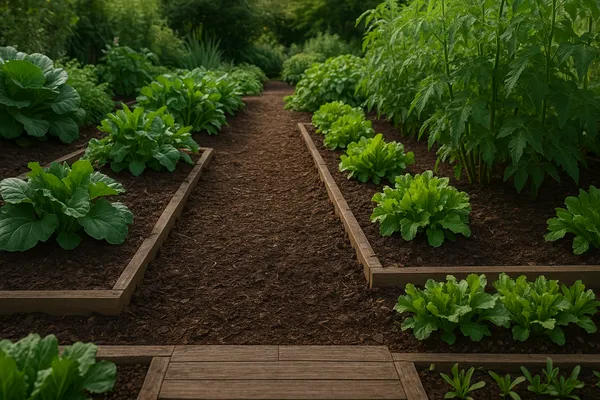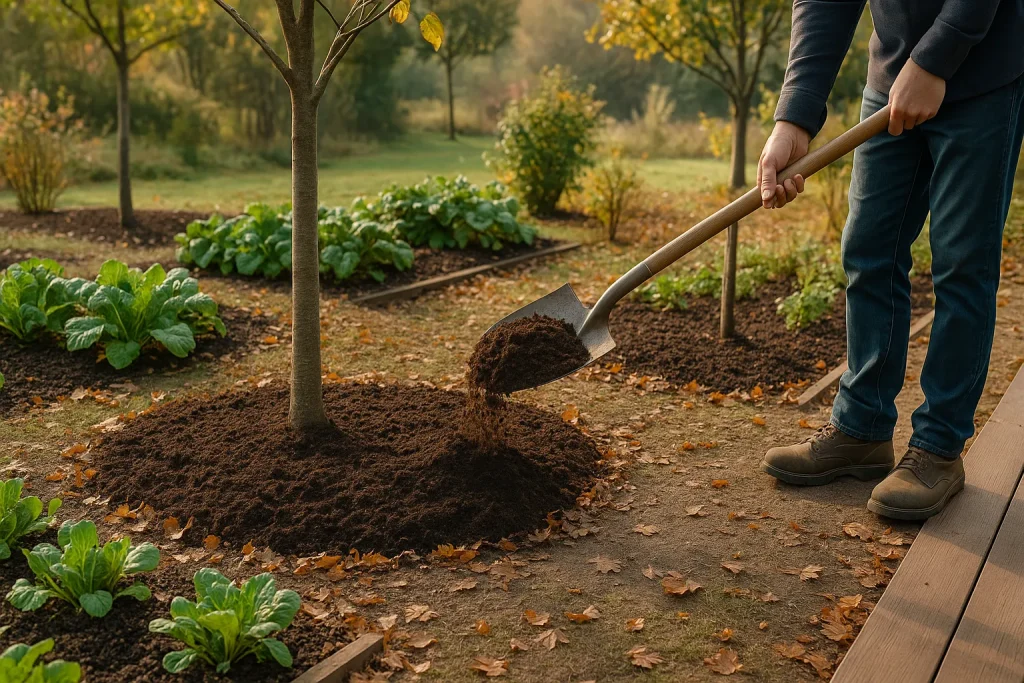Avoid your inquiry is delay response, please enter your WhatsApp/Skype along with the message, so we can contact you at the very first time.
We will reply you within 24 hours. If for urgent case, please add WhatsApp/WeChat:
Warning: Undefined variable $public in /www/wwwroot/lvfertilizer.com/wp-content/themes/hyhadmin/header.php on line 350
Warning: Trying to access array offset on value of type null in /www/wwwroot/lvfertilizer.com/wp-content/themes/hyhadmin/header.php on line 350
,. Or call
Warning: Undefined variable $public in /www/wwwroot/lvfertilizer.com/wp-content/themes/hyhadmin/header.php on line 350
Warning: Trying to access array offset on value of type null in /www/wwwroot/lvfertilizer.com/wp-content/themes/hyhadmin/header.php on line 350
directly.
You want free plant food, but the numbers don’t add up. Pure compost from leaves is gentle and slow, so crops stall if you expect a quick kick. The fix is simple: use leaf compost to build soil, then add targeted nutrition where needed.
Leaf compost doesn’t have fixed npk numbers. Typical nutrient levels are very low; the actual nitrogen is about 0.5 to 1.0 percent on a dry basis, with tiny phosphorus and potassium. Think of it as a soil builder and fertilizer support, not a standalone feed.

When gardeners ask for the npk values of leaves, they’re usually thinking like a bagged fertilizer label. But composted leaves work differently. Most university tests show the nitrogen content of composted leaves is modest and releases slowly. In plain terms, you’ll get soil-building first, yield boosts later.
Analyses often report composted leaves on a dry basis. Typical ranges for leaves on a dry basis show 0.5 to 1.0 percent N and very small P and K (reported as phosphate and potash). That “low number” is normal; method used (species, moisture, time) shifts the nutrient content slightly, but not enough to equal a concentrated feed. Gardeners on the forum at permies also note that different trees contribute differently over time.
Key point: Leaf compost improves soil first—nutrition arrives as microbes unlock it.
Leaf compost turns lifeless dirt into living soil. As leaves decompose, they form humus, making beds loamy, friable, and pleasantly crumbly so roots get better penetration. That structure boosts water holding capacity and water retention, especially during heat spells.
The magic is biological: each handful teems with a microbe party—soil microbes, enzyme activity, and a rich fungal web (including helpful fungus) that ferries nutrients from deep layers to your crop’s root zone. Earthy allies like the humble worm stitch the organic matter through the profile, keeping plant growth steady and resilient. This is why farmers call leaf compost a long-game amendment.
Leaf mould (also written leafmold/leaf-mould) is best used as a soil conditioner. Its main gift is organic matter, not high NPK. Spread it to improve texture, boost organic matter content, and buffer mineral salts so roots aren’t shocked.
Do you still need feeds? Yes—especially for heavy feeders. Pair leaf mould with targeted nutrition: for example, in flowering phases many growers add a balanced fertilizer or specialty blends. Explore options such as NPK 10-10-10 compound fertilizer for baseline feeding or water-soluble NPK 20-20-20 for fast uptake in fertigation.
You can make leafmould with a compost bin, a compost heap, a compost pile, or even bags of leaves. For speed, shred dry fall leaves from deciduous trees to increase surface area—they’ll decompose faster. Keep the pile evenly moist and aerated.
Expect decomposition to take 6 to 8 months in warm, moist conditions (longer if cool). The temperature of the soil and air matters; too cold or too dry slows everything. A white, harmless fungus on leaves signals the leaf mould process is working: that’s the fungal workforce converting leaves into silky, dark, sweet-smelling material.
Use leaf mould as mulch around beds and paths. A layer about 3 inches deep moderates swings in soil moisture, improves water retention, and protects tender roots. In borders with perennial plants, mulch yearly to maintain structure.
For vegetable beds, apply garden compost plus leaf mould in fall or early spring. Many growers prefer no-dig: avoid deep till, and let worms carry the compost downward. If you do cultivate, keep it shallow to protect biology. Pair off-season mulch with a cover crop to anchor and feed the soil through winter.

It depends on the crop. Leaf compost can partly replace manure for light feeders, but heavy feeders often need extra N. Gentle boosts include mixing in coffee grounds, a little poultry manure or cow manure, or even alfalfa pellets. For a lawn quick-green, some gardeners use a pinch of urea or a targeted nitrogen fertilizer—always carefully and in line with local guidance.
Remember, synthetic fertilizers act fast but don’t build soil structure. Your winning combo: compost for the base, plus crop-specific nutrition. For example, drip-friendly options like NPK 15-15-30 water-soluble let you spoon-feed as plants grow.
In containers, use a proven mix; pure leaf compost can be too dense for a seedling. Blend with potting soil for drainage and air. A small portion of screened leaf compost adds biology, but keep it modest to avoid acidic swings and soggy roots.
Planting a new garden or moving up to a larger pot? Work a light layer of screened compost into the top few centimeters and water well after you transplant. For fruiting crops, supplement mid-season with a soluble feed such as NPK 12-12-36 water-soluble fertilizer.
If your pile runs cold, you can nudge N. Mix 4 parts leaves to 1 part grass clipping; or layer small amounts of poultry manure, cow manure, or coffee grounds. As you mow, collect shredded leaves—this also increases surface area for faster heating.
Avoid overdoing strong sources like urea. Over-application can burn roots and harm biology. If you need precision, consider a balanced NPK like NPK 12-12-12 compound fertilizer or a specialized nitrogen product applied lightly and watered in.
Spread leaf compost in fall to capture winter moisture, then top-up in spring. For trees and shrubs, maintain a donut of compost beyond the dripline for root penetration and steady plant growth. For vegetable beds, add a thin layer before planting and side-dress mid-season.
Some growers prefer integrating a small amount before planting—with a rake, not a deep till—then mulching. Others keep compost strictly on the surface to protect networks of fungi and soil life. Either way, the goal is the same: a resilient, living soil.

Table 1. What leaf compost offers vs. what you still add
| Benefit or Need | Leaf Compost Contribution | What to Add (Examples) |
|---|---|---|
| Structure & loamy texture | High (improves friability) | — |
| Water retention | High | — |
| Fast nitrogen for fruiting | Low | NPK 20-10-10, CAN, light urea if needed |
| Flower/fruit support (P & K) | Low | Calcium Ammonium Nitrate + targeted K where needed |
| Long-term biology | Very high | Keep adding mulch yearly |
Case note: We supply tailored programs for distributors and farm co-ops. A typical field plan uses compost pre-plant, then drip feeding with NPK 15-15-30 water-soluble during bloom and fruit set, plus foliar K as needed. NPK products make it easy to match stage-wise demand.
“Build soil for resilience; feed crops for performance.”
Used correctly, no. Problems arise only when piles are unfinished or spread too thick right before planting. Let material finish into a sweet, earthy, crumbly texture before heavy application. Screen it for seed starts, and don’t bury stems.
If salts are a worry, water deeply after top-dressing to leach excess mineral salts. For sensitive crops, side-dress lightly and observe. Gentle, steady additions beat big dumps.
Pro tip: For tree lines and perennials, a steady mulch program pays off every year.
What species make the best leaf compost?
Most deciduous leaves work well. Avoid thick mats of waxy species unless you shred them. Mixed species give a broader trace mineral profile for the soil.
Can I use leaf compost alone for seedlings?
Use a blend. Straight leaf compost can hold too much water for a seedling; mix with potting soil for air space and drainage.
Is leaf compost acidic?
Unfinished leaves can test slightly acidic, but mature compost trends neutral and safe for most crops. Always apply thinly and water in.
Should I till compost in?
Many prefer shallow incorporation or no-dig. Deep till can break fungal networks. Surface mulching lets biology do the mixing.
Can leaf compost replace fertilizer?
It replaces part of your program, not all of it. Pair it with targeted nutrition. For examples, see custom NPK compound fertilizer options from our plant.
As a leading China producer and exporter, we support Agricultural Distributors & Importers, Commercial Farm Owners & Cooperatives, Government & NGO agricultural projects, and Fertilizer Brand Owners (OEM). Our catalog spans balanced compounds and specialty solutions that pair perfectly with your compost-first strategies—helping you scale what works in the field. See our About us and explore program-ready SKUs such as NPK 12-12-12 TE and ammonium sulphate 20.5%.
| Stage | Action | Why it helps |
|---|---|---|
| Pre-plant | 1–2 cm leaf compost + base NPK | Structure plus baseline nutrition |
| Vegetative | Light nitrogen boosts via fertigation | Pushes canopy without salt stress |
| Bloom/Fruit | Add P/K as needed | Support flowers, fruit fill |
| Post-harvest | Mulch + cover | Protects soil, maintains biology |
Data note: Values above are generalized from common extension-style guidance and practical farm usage; always test your soil and adjust programs for crop, climate, and timing.
Remember these essentials:
Glossary hits to help you scan and use this guide
If you’d like a tailored nutrient plan that pairs leaf compost with stage-specific inputs for your crops and climate, we can help distributors and co-ops design simple, scalable programs.